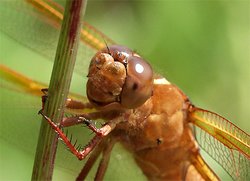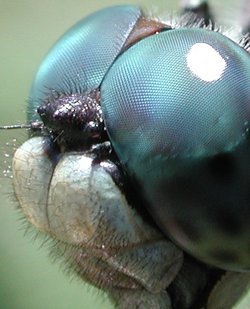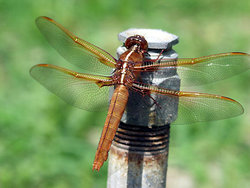Dragonfly
|
|
| Dragonflies | ||||||||||
|---|---|---|---|---|---|---|---|---|---|---|
 Blue dragonfly | ||||||||||
| Scientific classification | ||||||||||
| ||||||||||
| Families | ||||||||||
|
Aeshnidae - Hawkers |
The dragonfly is an insect belonging to the Order Odonata, Suborder Anisoptera and characterized by large multifaceted eyes, two pairs of strong transparent wings, and an elongated body. Dragonflies typically eat mosquitoes, midges and other small insects like flies, bees, and butterflies. They are usually found around lakes, ponds, streams, and wetlands for the reason that their larvae (known as nymphs) are aquatic. Dragonflies do not bite or sting humans.[1] In fact, they are valued as a predator that helps control the populations of insects that do, such as mosquitoes.
| Contents |
General facts
The life cycle of the dragonfly, from egg to death of adult, is from six months to as much as six or seven years. Female dragonflies lay eggs in or near water, often in or on floating or emergent plants. Most of their life cycle is spent in the larval (nymph) form, beneath the water surface, using internal gills to breathe, catching other invertebrates or even vertebrates such as tadpoles and fish. In the adult (flying) stage, larger species of dragonfly can live as long as four months. Dragonflies have very good eyesight due to their unique eye structure. Dragonflies have up to 30,000 facets to their eyes, each one is a separate light-sensing organ or ommatidia, arranged to give them nearly a 360° field of vision.Much larger dragonfly species existed in the distant past than occur on earth today. The largest, found as a fossil, is an extinct Protodonatanamed Meganeura monyi from the Permian period with a wingspan of 70–75 cm (27.5–29.5 in). This compares to 19 cm (7.5 in) for the largest modern species of odonates, the Hawaiian endemic dragonfly, Anax strenuus. The smallest modern species recorded is the libellulid dragonfly, Nannophya pygmaea from east Asia with a wing span of only 20 mm, or about 3/4 of an inch.

The Common Green Darner dragonfly (Anax junius) is nicknamed "Darning Needle" because of its body shape. It is one of the biggest and fastest-flying dragonflies, able to reach speeds of 85 km/h (53 mph).
Damselflies (Suborder Zygoptera) are often confused with dragonflies, but the two insects are distinct: damselflies at rest hold their wings together above the body, whereas dragonflies at rest hold them out, either horizontally or slightly down and forward. Also, the eyes on a damselfly are separated, while those of the dragonfly are nearly touching. Both are members of Odonata, and their life cycles are similar.
Motion camouflage
It was recently discovered that dragonflies employ an optical illusion to stalk other insects who invade their territory. A dragonfly can move in such a way as to project itself as a stationary object while speedily attacking its victims, new research suggests. These findings illustrate for the first time how dragonflies use complex camouflaging techniques during aerial combat.
Clipart and Animal Pictures
- Clipart (https://classroomclipart.com/image/category/clipart.htm)
- Animal Clipart (https://classroomclipart.com/image/category/animal-clipart.htm)
- Animal Animated Clipart (https://classroomclipart.com/clipart/Animations/Animals.htm)
- Pictures of Animals (https://classroomclipart.com/image/category/animal-photos.htm)
- Amphibian Clip Art, Pictures and Photogaphs (https://classroomclipart.com/image/category/amphibian-clipart.htm)
- Farm Animal Clip Art, Pictures and Photographs (https://classroomclipart.com/image/category/farm-animal-clipart.htm)
- Mammal Clip Art, Pictures and Photographs (https://classroomclipart.com/image/category/mammal-clipart.htm)
- Marine Animal Clip Art, Pictures and Photographs (https://classroomclipart.com/image/category/marine-life-clipart.htm)
- Reptile Clip Art, Pictures and Photographs (https://classroomclipart.com/image/category/reptile-clipart.htm)
- Spider Clip Art, Pictures and Photographs (https://classroomclipart.com/image/category/spider-clipart.htm)
- Dragonfly Photographys (http://classroomclipart.com/clipart/Animals/Insects/Dragonflies.htm)
Some common species
- Emperor Dragonfly, Anax imperator
- Black-tailed Skimmer, Orthetrum cancellatum
- Common Whitetail, Libellula lydia
- Migrant Hawker, Aeshna mixta



